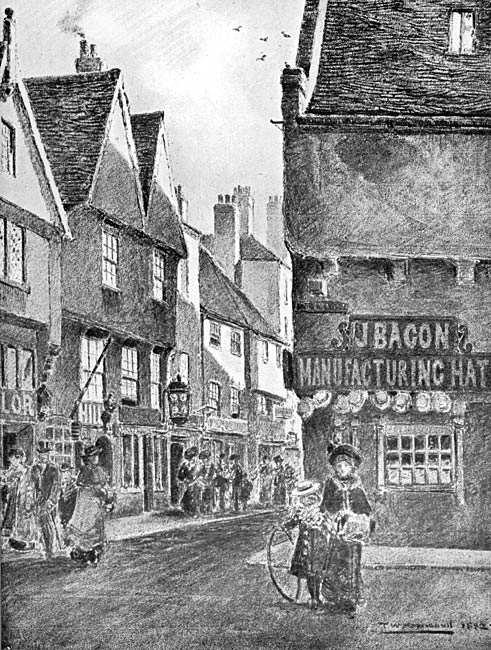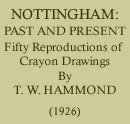< Previous | Contents | Next >
NOTTINGHAM PAST & PRESENT: STREETS AND YARDS
CORNER OF ST. PETERS GATE AND BRIDLESMITH GATE, 1882

Bridlesmith Gate, whose name enshrines one of the principal trades of ancient Nottingham, was until a century ago the main shopping street of the town. So important was it, that in 1819 when gas was introduced as a street illumination into the town, five out of the ten lamps set up were apportioned to Bridlesmith Gate.
It has always been an extremely narrow thoroughfare and in 1810 an effort was made to overcome t'lis disadvantage. A public subscription was raised and a start was made at the Pavement end to widen it to such an extent that two carriages might pass. However, funds gave out before this improvement had proceeded very far, but the effort then made explains the curious widening which still exists at the south end of the street. Nine years later, fresh efforts were made to improve the street; the shop keepers trading in it agreed to do away with their overhanging signs which tended to impede the already congested traffic, and the footways, which are amongst the earliest footways in the town, were paved with flags instead of boulders which had hitherto satisfied our forefathers. So pleased were the proprietors with the results of their efforts that they tried to change the name of the street from Bridlesmith Gate to Bond Street, after the Bond Street in London, which was as fashionable a shopping street a hundred years ago as it is to-day.
The house with the double gable and its overhanging upper stories reminds us of one of the ways in which encroachments were made upon the streets in ancient days. As the beams carrying these overhanging stories became weakened by age, they were strengthened by the addition of posts from their outer end right down to the street level. These posts, of course, got in the way of traffic, but it was the business of no-one in particular to see that they were removed and they gradually became permanent, so that when a new house was erected upon the site, the line of these posts was looked upon as the boundary of the site and all sorts of strange encroachments in our streets may be accounted for in this manner.
